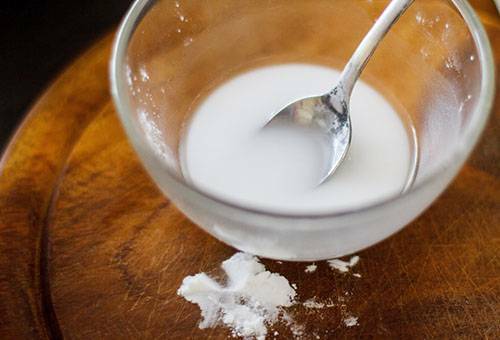Content:
- Preparation of starch solution
- What is not starch?
- How else can I starch a thing?
- Alternatives for
How to starch things and why do you need to do this? When starching, a thin film forms on the surface of the fabric, which makes it denser and better holds the mold. In addition, due to this film, any contamination does not penetrate deeply into the structure of the tissue, which means that it is easy to wash. And if it's a light, but slightly yellowed with time thing, then the starch will lightly bleach it and give a more fresh look. The only drawback of starched clothes is that it allows less air, that is, it will not be very comfortable on a hot day.

Preparation of starch solution
For starching things at home, you can use any starch - corn, wheat, potato. There is no significant difference in the result in this case. Although many housewives note that starch from corn thickens worse than from potatoes.
Depending on the material of clothing or linen, a different amount of starch per liter of water is added to the water.
- For thin fabrics like chiffon, organza, cambric, tulle, half a teaspoon will suffice.
- For bedding, various decorative napkins and clothes, usually add a whole teaspoon.
- For individual items of clothing that must be particularly tight, collars or cuffs, for example, or a petticoat, two teaspoons of starch are already used.
The starch must be diluted in a container of cool water, mix thoroughly, and then pour in a small amount of hot liquid. As a result, a completely transparent thick paste must be obtained. If the mixture is not transparent enough, it can be heated for several minutes.
Board
If you can not make a starch solution without lumps, then the mixture can be filtered through cheesecloth to get rid of them.
How correctly to starch? Do this only with clean things without any stains. They can be either dry or slightly damp, it does not matter. It is necessary to lower the product into a starch liquid, allow it to soak properly, and then take it out and squeeze it slightly to remove excess water. Starched things at home are dried at room temperature. Do not place them near the heating devices, otherwise they will dry unevenly, and they will be uncomfortable to iron. By the way about ironing - it should be done on slightly damp products. And here is how to starch a bow, which is better not to iron, so as not to melt the fabric? He will have to give shape manually.

What is not starch?
- Do not starch or gelatinize underwear, because the procedure makes it airtight, which is bad from a hygienic point of view.
- Black and simply dark things do not fit for starching-they leave noticeable white stains on them.
- It is meaningless to starch, sugar or gelatinize synthetic clothes - there will be no special result.

How else can I starch a thing?
"Starvation" starching is a long and laborious process. Now there are much more convenient ways, how to starch things. You can buy starch-containing sprays or liquids that are extremely easy to use - they spray the thing while ironing.
For starching large items, for example, bed linen or long clothes, it is worth buying powders or conditioners for laundry with the corresponding effect, which are simply added when washing into the machine. In principle, a mixture of starch and water can be added to the machine. But how to starch the fabric in this way and not spoil the technique? The solution should be filled in the air conditioner compartment( strictly in place of it, not with it), and after washing it is necessary to wipe the drum and machine door with a dry clean cloth to remove the whitish coating from the remains of starch.
Advice
It is convenient to starch and gelatinize the linen by pouring a weak solution into a spray gun. But more saturated mixtures will be difficult to spray because of their density.

Alternatives for
In addition to these customary ways for any hostess to give things shape and make it more rigid there are other, less popular, but no less effective.
- Mix sugar with water ( about 200 g of sugar per 100 g of water) and heat the mixture until the sugar dissolves completely. The main thing is not to digest the syrup, otherwise it will give the things yellowness.
- Dilute PVA in water. It is better to use a building glue, because it is more white and does not give yellowish divorces on light products after they have dried. In this way, needlework is often used in the manufacture of artifacts made of fine fabrics, for example, tulle.
Instead of starching the laundry to get the same result it can also be gelled. To do this, 3-4 teaspoons of gelatin per liter of water is diluted in cold water, the mixture is heated almost to boiling, but not brought to it, mixed until a homogeneous consistency and complete dissolution of the gelatin. Next, the solution should be allowed to cool slightly, so that it was still hot, but not burning, and then soak the product in it for a few minutes, then squeeze it lightly and hang it.
Ideal ways to shape a specific product and the proportions of components in mixtures for processing a particular thing can not be foreseen in advance, each hostess selects them experimentally. But the general rule is that the thinner the fabric, the less saturated the solution must be, ie, for example, much less starch will be needed for tulip than for a cotton shirt.

